Value Chain Analysis (PowerPoint PPT Slide Deck)
PowerPoint (PPT) 16 Slides
VALUE CHAIN ANALYSIS PPT DESCRIPTION
Developed by Michael Porter, Value Chain Analysis is strategic management framework used to analyze the processes and key activities performed by a business or industry. This framework illustrates where value is created within an industry or company.
The conventional view of the Porter Value Chain (depicted in a multi-level chevron diagram) captures 5 primary activities and 4 support (secondary) activities:
Primary Activities
• Inbound Logistics
• Operations
• Outbound Logistics
• Marketing & Sales
• Service & After Sales Support
Support Activities
• Firm Infrastructure
• Human Resource Management
• Technology Development (IT)
• Procurement
Through Value Chain Analysis, we can identify areas of competitive advantage (or disadvantage) by benchmarking cost drivers. It also provides a structure for performing competitive analysis by separating the value generating stages. This analysis also allows your organization to analyze opportunities for backward and forward integration by including suppliers and end-customers in the Value Chain.
Value Chain Analysis also drives strategic hypotheses to answer several critical strategic management questions:
• Where are we, and our competitors, earning money? Why?
• Should we forward or backward integrate?
• Should we outsource or spin-off value activities (i.e. business processes)?
• What are the industry critical success factors?
• What are our managerial action plans to control costs, improve service, and increase delivered value?
This Value Chain Analysis PPT presentation breaks down a 4-step process to Value Chain Analysis:
1. Identify the industry Value Chain and map the linkages between the industry value activities.
2. Assign costs, revenues and assets to value activities.
3. Determine the relevant cost drivers for each value activity.
4. Identify potential competitive advantages by either controlling cost drivers better than competitors or reconfiguring the value chain to better leverage the organization's strengths.
Value Chain Analysis is a powerful tool in Strategic Management. This PowerPoint presentation provides an in-depth explanation of the framework with detailed examples and is the same training material used by global management consulting firms.
This presentation also includes detailed industry examples, such as the paper products industry, to illustrate practical applications. It emphasizes the importance of identifying cost drivers and understanding competitive trends to optimize your value chain strategy.
Got a question about the product? Email us at support@flevy.com or ask the author directly by using the "Ask the Author a Question" form. If you cannot view the preview above this document description, go here to view the large preview instead.
Source: Best Practices in Value Chain Analysis PowerPoint Slides: Value Chain Analysis PowerPoint (PPT) Presentation Slide Deck, LearnPPT Consulting
VALUE CHAIN ANALYSIS PPT SLIDES
This document is available as part of the following discounted bundle(s):
Save %!
Competitive and Company Cost Analysis
This bundle contains 5 total documents. See all the documents to the right.










